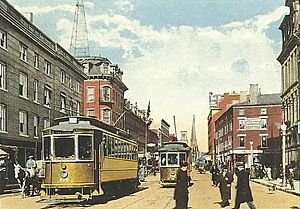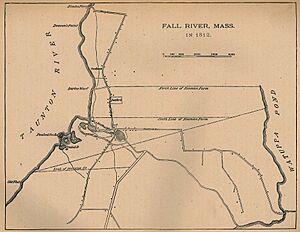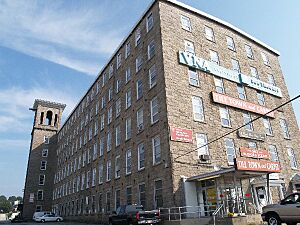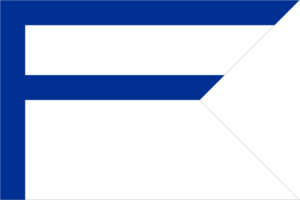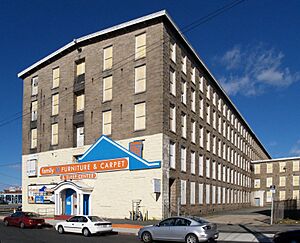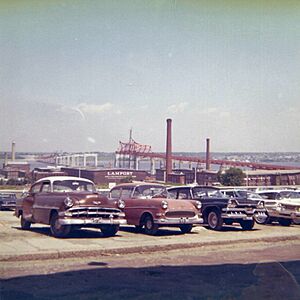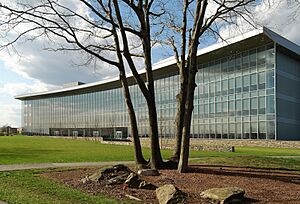History of Fall River, Massachusetts facts for kids
Fall River, Massachusetts, has a long history shaped by its cotton textile industry. It started as a small farming area near the Plymouth Colony. In the 1800s, it grew into the biggest textile city in the United States, with over 100 mills by 1920. Even though the textile factories closed down in the 1900s, their history still has a big impact on the city today.
Contents
Early Days of Fall River
When the Plymouth Colony was founded in 1620, the area that became Fall River was home to the Wampanoag tribe. Their main village was at Mount Hope. The city's name comes from the Quequechan River, which locals say "Quick-a-shan." This Wampanoag word means "Falling River" or "Leaping Waters."
In 1653, people from the Plymouth Colony settled Freetown, Massachusetts. This area included the northern part of what is now Fall River. In 1683, Freetown became a town. The southern part of Fall River became the town of Tiverton in 1694. Later, in 1746, the border between Rhode Island and Massachusetts was changed. Tiverton became part of Rhode Island. The state border is now near Columbia Street.
In 1703, Benjamin Church, a hero from King Philip's War, built mills on the Quequechan River. He had a sawmill (for cutting wood), a gristmill (for grinding grain), and a fulling mill (for cleaning wool). In 1714, Church sold his land and water rights to Richard and Joseph Borden. This sale became very important 100 years later. It helped the Borden family lead the growth of Fall River's textile industry.
By the mid-1700s, the Borden family ran several mills on the Quequechan River. People also settled in the northern part of Fall River, along what is now North Main Street. The oldest house still standing in Fall River was built in 1750.
The Battle of Freetown
During the American Revolutionary War, on May 25, 1778, a battle happened in Freetown. About 150 British soldiers sailed up Mount Hope Bay. They landed near the Quequechan River. Local soldiers, called minutemen, saw them and started firing. The British burned some buildings, including mills and homes belonging to the Borden family. They also took Richard Borden prisoner, but he was later released. The British then left Freetown. Local militias helped the minutemen. The British had two soldiers hurt, but the colonists had no losses.
Later, in 1788, a famous French war hero, the Marquis de Lafayette, visited the area. He stayed with Joseph Durfee's father, Thomas Durfee. Today, Lafayette Park in Fall River is named after him.
Fall River Becomes a Town
On February 26, 1803, "Fallriver" was officially made a town in Massachusetts. A year later, on June 1, 1804, the town changed its name to "Troy." The name "Troy" was used for 30 years. On February 12, 1834, it officially became "Fall River" again.
The early town had about two dozen families. Important family names included Borden, Durfee, Buffington, Davol, and Cook.
The first church in Fall River, the First Congregational Church, started in 1816. Other early churches included the First Baptist Church (1825) and the Methodist Church (1826). Irish Catholics built their first church, St. John the Baptist, in 1840.
Two Fall Rivers
For a while, the southern part of Fall River (south of Columbia Street) was still part of Tiverton, Rhode Island. In 1856, Tiverton voted to separate its northern industrial area, creating Fall River, Rhode Island. In 1861, after many disagreements, the United States Supreme Court moved the state border. This made the City of Fall River entirely within Massachusetts.
The Great Fire of 1843
By 1843, Fall River was a busy town with about 8,000 people. On July 2, 1843, a fire started around 4 p.m. Two boys were playing with a small cannon, and it set wood shavings on fire. Strong, dry winds helped the fire spread quickly. It burned down 291 buildings in the center of town.
About 200 families lost their homes. The town lost important shops, the post office, hotels, churches, and banks. People from other cities like Boston and Providence donated over $50,000 to help.
Early Factories and Growth (1811-1865)
Fall River's textile industry grew from ideas in nearby Rhode Island. The first textile mill in Fall River was the Globe Manufactory, built in 1811 by Col. Joseph Durfee. It was a spinning mill.
But the real growth happened along the Quequechan River. Its eight waterfalls made Fall River a perfect place for factories. The Fall River Manufactory and the Troy Cotton & Woolen Manufactory were both started in 1813. Oliver Chace, who had worked for Samuel Slater (a textile pioneer), helped found the Troy Mill. In 1817, the Fall River Manufactory installed the city's first power looms.
Fall River Iron Works
In 1821, Col. Richard Borden and Maj. Bradford Durfee started the Fall River Iron Works. They made nails, metal bars, and other items. They became known for high-quality nails, and their business grew. By 1845, the company was worth a lot of money. Richard Borden also started regular steamship service to Providence in 1827.
The iron works were important for the early textile industry. Richard Borden later built the Metacomet Mill in 1847. This is the oldest textile mill still standing in the city today.
Cloth Printing
In 1824, Andrew Robeson started the first print works in Fall River. This part of the industry became very important later on. By 1833, Fall River had 13 cotton mills, employing 1,200 people.
The American Print Works was started in 1835 by Holder Borden. With the Borden family's leadership, the American Print Works became the biggest and most important textile company in the city. It employed thousands of people.
Other Factories and Infrastructure
Oliver Chace started a thread mill in 1838. It is the oldest textile factory building still standing in the city, though it never made cloth.
By 1845, the Quequechan River's power was fully used. The Massasoit Mill, built in 1846, was the first mill in the city to use a steam engine. Later, better steam engines allowed for even larger mills, like the Union Mills in 1859.
Fall River's port was very important. It became a port of entry in 1837. Coal and iron were imported through the port. Colonel Richard Borden also started the first railroad line to Fall River in 1844. Two years later, a luxurious steamship service called the Fall River Line began. It connected rail travelers from Boston to New York City until 1937.
In 1854, Fall River officially became a city. Its population was about 12,000. The Borden family had control or business interests in the city's banks, gas company, steamboats, railroads, and mines for three generations.
Fall River: "King Cotton" City (1865-1923)
Fall River did very well after the American Civil War. By 1868, it had more textile machines than Lowell, becoming the top textile city in America. It held this title until the mid-1920s.
After a fire in 1867, the American Print Works was rebuilt in 1868. Many new mills were built in the late 1860s. Then, in 1871 and 1872, the city grew even more. Fifteen new companies started, building 22 new mills. The city's population grew by 20,000 people in just two years!
On September 19, 1874, a terrible fire happened at the Granite Mill. The fire blocked the exits. Fire department ladders were not tall enough to reach people. Thirty people died trying to escape the flames. After this tragedy, all mills had to have at least two exits and metal fire escapes.
By 1876, Fall River produced a huge amount of cotton cloth. It became known as the "Spindle City." It was the second-largest textile city in the world, after Manchester, England.
To house the thousands of new workers, mostly Irish and French Canadian immigrants, many company homes were built. These were often three-story "triple-decker" buildings with several apartments.
Fall River also became famous for its granite rock. Many mills and public buildings were built from this local stone.
In 1911, the city celebrated its textile industry with the "Cotton Centennial." President William Howard Taft even attended.
The Textile Industry Slows Down
The cotton mills in Fall River mostly made one product: print cloth. Around 1910, the American Printing Company (APC) was the city's biggest employer. It had 6,000 workers and was the largest cloth printer in the world. Many other mills in the city made print cloth just for the APC.
World War I created a high demand for textiles, which helped the mills. But after the war, the economy slowed down. Mills in the South became strong competitors. They had lower labor costs and newer machines. In 1923, Fall River saw its first mill closures. In 1924, the American Printing Company opened a new factory in Kingsport, Tennessee, moving many jobs there. By the 1930s and the Great Depression, many more mills closed, and the city went bankrupt. A few mills managed to stay open until the 1950s.
The worst fire in Fall River's history happened on February 2, 1928. It started at the Pocasset Mill and quickly spread, destroying a large part of downtown. City Hall was damaged but saved. Many buildings in downtown Fall River today were rebuilt after this fire in the early 1930s.
The American Printing Company finally closed for good in 1934. In 1937, the Firestone Tire and Rubber Company bought its huge factory. It employed 2,600 people. In 1941, a huge fire broke out there, destroying $15 million worth of rubber. This was a big setback for the U.S. war effort.
By 1940, only 17 textile companies were still open, compared to 49 in 1917. As the textile industry declined, many mills were used by smaller companies, like the garment industry. This industry lasted in Fall River until the 1990s but also faced competition from other countries.
Modern Fall River
In the 1960s, Fall River changed a lot. The Braga Bridge and Interstate 195 were built, cutting through the city. The historic Quequechan River was filled in and moved underground. Many old buildings were torn down, including the Old City Hall and the 150-year-old Troy Mills.
The new city hall, called "Fall River Government Center", opened in 1976. It was built in a style popular in the 1960s and 1970s.
In the 1970s, several tall apartment buildings were built for housing. Many of these now serve as homes for older people. In 1978, the new B.M.C. Durfee High School opened. It is one of the largest high schools in Massachusetts.
Recent History
In the 1980s, Fall River had three more big fires. No one died, but the city lost important historic buildings.
On November 5, 1981, the 100-year-old Richard Borden Mill caught fire. Firefighters worked hard to stop the fire from spreading to a nearby gas station.
A few months later, on May 11, 1982, a fire started at the Notre Dame de Lourdes Church. Strong winds and dry wood caused the fire to spread quickly. The church and many nearby apartment buildings were destroyed. A new church was built in the same spot in 1986.
Finally, on January 12, 1987, the huge Kerr Mill Complex was destroyed by a massive fire. Many companies were in these mills, and over 900 people lost their jobs. The Kerr Mill site was rebuilt in the late 1990s. Today, it is home to the Advanced Technology & Manufacturing Center of UMass-Dartmouth and the Meditech building.
City Leadership
In January 2016, Jasiel Correia became the youngest mayor in Fall River's history at age 23. He was later replaced by Paul Coogan in November 2019.
See also
- American Printing Company (Fall River Iron Works)
- Oliver Chace
- Colonel Richard Borden
- Metacomet Mill
- List of mills in Fall River, Massachusetts
- National Register of Historic Places listings in Fall River, Massachusetts
- List of mayors of Fall River, Massachusetts
- Fall River Female Anti Slavery Society
- Lizzie Borden


